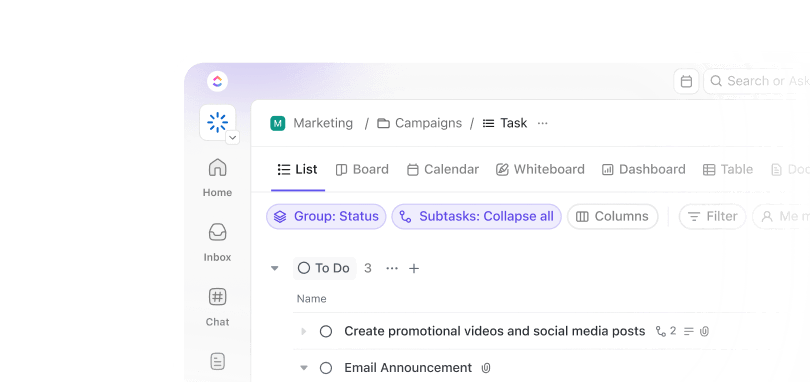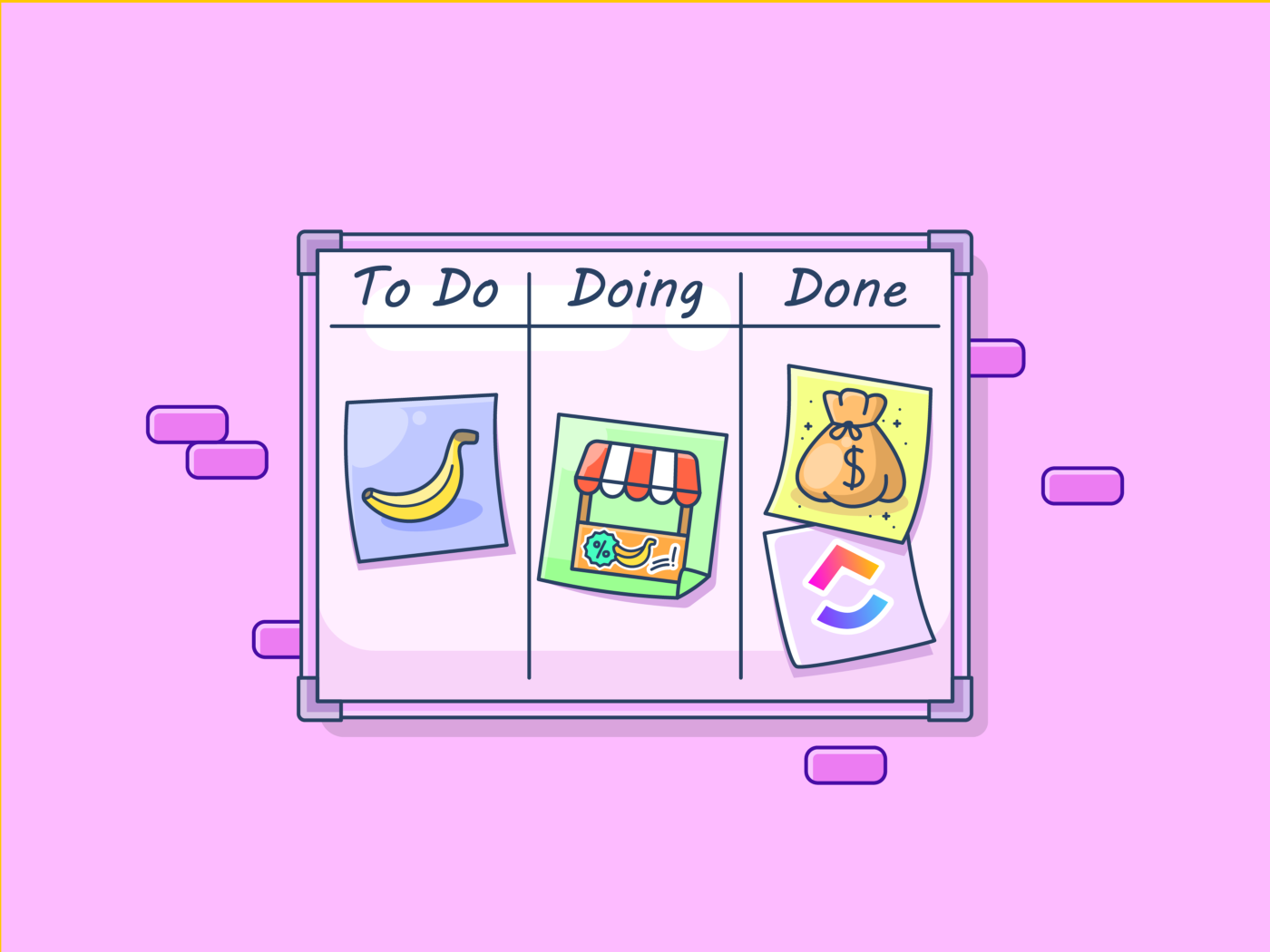Looking for an AI system to keep up with your project effectively? Utility-based agents are the answer.
Utility-based agents in AI play a crucial role in smart decision-making. These agents solve complex problems, adapt to dynamic environments, and improve efficiency.
Without utility-based agent tools, efficiency often falls short. For project managers, this means wasted resources, missed deadlines, and reduced productivity.
In this blog, we’ll delve into what utility-based agents in AI are, how they function, their advantages and limitations, and how you can leverage them for effective project management.
⏰ 60-Second Summary
- Utility-based agents: AI agents that make decisions by selecting options based on expected utility
- Key components: Assigns numerical values to outcomes, adapts to new information, and improves decision-making
- How they work: Gathers data, evaluates options, and refines decisions over time
- Applications: Optimizes routes, personalizes recommendations, and improves patient care
- Benefits: Handles complex environments, anticipates issues, and is versatile across applications
- Limitations: Resource-intensive, dependent on accurate models, and lacks agent collaboration
- : Prioritizes tasks, allocates resources efficiently, and balances competing goals like time, cost, and quality
How to Leverage Utility-Based Agents in AI Systems
What Is a Utility-Based Agent in AI?
A utility-based agent evaluates various options and selects the one with the most expected utility. This indicates that the tool decides by assessing the potential quality of the outcomes.
When handling complex tasks under tight deadlines and limited resources, a utility-based agent assesses resource allocation, prioritizes tasks, and gauges team availability. This assessment aids in identifying the most efficient route to meet project objectives while balancing time, cost, and quality.
Components of utility-based agents
Utility-based agents are powered by four conceptual components that make them capable of advanced decision-making:
1. Utility function
The goal-based agent’s utility function assigns numerical values to different outcomes, reflecting how desirable they are to the intelligent agent. A higher value indicates a more preferred outcome. For instance, a shorter route with less traffic might have a higher utility value in a route planning scenario.
2. Performance element
This component executes the actions decided upon by the utility function and ensures that the agent’s actions align with its goals. The performance element monitors the agent’s performance against a fixed standard, providing feedback to the learning element.
3. Internal model
The internal model helps the agent understand its environment and predict future outcomes. It’s particularly crucial in complex or dynamic environments where conditions change rapidly. By tracking the world’s state, the agent makes more informed decisions.
4. Learning element
The learning element takes feedback from the environment to refine the agent’s preferences and utility function. With time, the agent becomes capable of making better decisions. This is essential for agents operating in real-world scenarios where conditions are constantly changing.
How Utility-Based Agents Work

Utility-based agents follow a systematic approach to make optimal decisions in complex environments. Here’s a step-by-step breakdown of how they work:
1. Perceiving the environment
The process begins with the utility-based agent observing its environment. Using data inputs, it gathers information about its current state and any relevant factors that may influence its decision. For example, the agent identifies task deadlines, team availability, and resource constraints in project management.
2. Building an internal model
Next, the agent uses an internal model to represent its environment. This model considers how the world evolves independently and how the agent’s actions affect outcomes. It helps the agent predict the consequences of different actions and make informed decisions.
3. Assigning utility values
The agent evaluates multiple possible alternatives and assigns utility values to each. The utility function maps these options to numerical values based on the agent’s preferences or performance standards. For example, a utility-based agent may assign higher utility to critical and time-sensitive tasks.
4. Choosing the highest expected utility
This step ensures the agent selects the most suitable path to achieve its goal. Project management could mean prioritizing tasks that optimize time, cost, and team productivity.
5. Executing actions
The performance element of the utility-based agent then carries out the chosen action. The agent continuously monitors its progress and adapts to changing circumstances to ensure it stays aligned with its goal.
6. Learning from feedback and refinement
The learning element takes feedback from the environment and refines the utility function. This step enables the agent to improve decision-making capabilities and adapt to new and informative experiences.
A real-world example:


, an all-in-one productivity tool, exemplifies a utility-based agent in action. It enables you to create tasks, set deadlines, assign them to team members, and prioritize work efficiently.
With features like workload management, time tracking, and progress reports, helps you evaluate the impact of different actions—shifting a deadline or reallocating resources to optimize team performance.


Once you’ve identified the best action, allows you to execute seamlessly. You can easily assign tasks, update timelines, and reorganize workflows, ensuring smooth collaboration across your team.
Post-project, its analytics features let you review outcomes and refine strategies for the future, creating a continuous feedback loop—just like a learning utility-based agent.
💡Pro Tip: Wish to automate your ideas to streamline your tasks?
Check out this guide to automations in (with 10 use case examples)
- 🏷️ Auto-assign team leads or add comments when tasks reach Completed
- 👥 Roll back task status when the assignee shifts from team leader to member
- 🔥 Change task status, archive tasks, or apply templates when priority drops
- ⏰ Move tasks up the list or archive when due dates hit
- ➕ Automatically associate new tasks with a List for smooth workflow
Applications of Utility-Based Agents
Utility-based agents are revolutionizing various industries by optimizing and allowing intelligent decision-making with AI tools. Let’s explore some key applications:
1. Autonomous vehicles
These vehicles use utility-based agents to evaluate road conditions, traffic, safety, and fuel efficiency. These agents calculate the highest expected utility to ensure optimal decisions.
For instance, Tesla’s Autopilot system combines computer vision, an internal model, and hierarchical agents to handle complex tasks like highway driving.
🔍 Did You Know? Self-driving cars are like having a super-smart robot chauffeur! 🤖 They use artificial intelligence to avoid accidents and find the best route to your destination. Isn’t the future of transportation pretty cool? 😎
2. Recommendation systems
Have you noticed how Netflix suggests the perfect show or Spotify curates your playlist? That’s utility-based artificial intelligence in action. These systems use utility functions to predict what you’ll enjoy most, balancing your preferences, browsing history, and time of day.
3. Smart grids
Smart grids utilize utility-based agents to optimize energy distribution and consumption. These agents can improve grid efficiency and reduce energy costs by considering factors like real-time demand, renewable energy sources, and energy storage.
For instance, they might redirect energy to high-demand areas during peak hours while maintaining overall utility across the grid. This ensures both sustainability and cost savings.
4. Financial trading
When it comes to trading, decisions must be precise and immediate. Utility-based agents analyze market trends, risk levels, and portfolio goals to execute trades.
For example, AI systems in trading platforms use numerical values to evaluate conditions and make profitable decisions.
5. Healthcare
Utility-based agents enhance patient scheduling, treatment planning, and resource allocation in healthcare. These agents optimize healthcare delivery and improve patient outcomes by considering factors like patient urgency, resource availability, and treatment effectiveness.
For example, an AI software agent in a hospital assesses patient data to recommend the best treatment options.
6. Logistics
Managing supply chains involves juggling costs, delivery timelines, and customer satisfaction. Utility-based agents revolutionize logistics by automating decisions like route optimization, warehouse operations, and inventory management.
For example, these agents can reduce costs and improve delivery times by analyzing factors like traffic conditions, fuel costs, and delivery deadlines.
💡 Pro Tip: Want to level up your real estate business?
Learn how to use AI in real estate to improve efficiency and client experience:
- 🔮 AI estimates property value in seconds, saving time and minimizing bias
- 📊 GenAI tools summarize lease info and filter key data instantly
- 🏗️ Create virtual tours, renderings, and cost estimates with AI
- 🛋️ Customize virtual spaces and order furniture seamlessly
Advantages of Utility-Based Agents
Utility-based agents bring a new level of intelligence to decision-making. They excel at navigating complex systems, solving problems, and adapting to dynamic circumstances.
Whether you’re a software developer or project manager, understanding the benefits of these agents helps you implement smarter, more efficient systems that drive success. Let’s break it down:
1. Adaptability to complex environments
Unlike simple reflex agents (AI systems that rely on predefined rules to make decisions), utility-based agents adapt to changing conditions.
In case of a project timeline shift, these goal-based agents assess new information and make informed choices to keep everything on track. This is necessary for sustained efficiency and better problem-solving in unpredictable scenarios.
2. Scalability across applications
Utility-based agents work seamlessly across various AI applications, from autonomous vehicles to intelligent systems for project management. You can manage a team of five or coordinate a global operation. These AI agents adjust to your scale and needs effortlessly.
3. Improved goal alignment
These goal-based agents don’t just complete tasks—they align with the bigger picture. While goal-based agents aim to hit specific targets, utility-based agents consider the overall impact.
They prioritize actions that maximize an organization’s value, making them ideal for systems with complex, interconnected goals.
4. High-level customization
Utility-based agents are as unique as your needs. Want to optimize healthcare treatment plans? Streamline energy usage? You’re in control. Tailor their utility functions to match your priorities, and they’ll help you achieve results that matter most to you and your industry.
5. Proactive problem-solving
Why wait for problems to arise when you can stay ahead? Utility-based agents don’t just react—they predict. By analyzing expected utility, these AI agents take proactive steps to address challenges before they escalate.
In project management, this helps you mitigate risks, stay ahead of potential delays, and maintain overall efficiency. This means ensuring smoother operations and encountering fewer surprises.
💡 Bonus: Explore the top 10 AI task managers—they’ll help you manage tasks like a pro while saving time and energy! ⚡📅
Limitations of Utility-Based Agents
While utility-based agents excel in solving complex problems and optimizing decision-making, they have limitations. Therefore, it’s essential to recognize them before diving into implementation:
1. Resource-intensive decision process
Utility-based agents are thorough problem-solvers who analyze countless actions to find the one with the highest expected utility. But this thoroughness has a cost: time and computational resources.
This process could slow you down if you’re managing smaller AI systems or working with real-time applications like fuel efficiency or energy management.
2. Dependence on accurate models
Utility-based agents rely heavily on an internal model to evaluate outcomes. The agent’s actions may not reflect reality if the model is flawed or incomplete.
For example, in natural language processing or computer vision tasks, errors in data interpretation could skew decision-making.
3. Not ideal for simpler problems
Sometimes, less is more. If you’re dealing with straightforward tasks, a simple reflex agent or model-based reflex agent might do the job just fine.
Utility-based agents bring unnecessary complexity to smaller or routine tasks, where quick condition-action rules are often more effective and efficient.
4. Lack of collaboration with other agents
Utility-based agents may fail to consider collective outcomes when working alongside other intelligent agents. Their focus on maximizing individual utility sometimes conflicts with broader system goals, especially in multi-agent or collaborative workflows.
5. Difficulty handling subjective preferences
Defining utility functions for subjective or human-driven goals is tricky. For example, balancing customer satisfaction with cost efficiency in AI-powered customer service tools requires careful fine-tuning.
Without clear numerical values to guide them, utility-based agents may struggle to find the “best” solution for tasks involving subjective decision-making.
💡Pro Tip: Want to learn How to Use AI in the Workplace to Boost Productivity?
Here’s your game plan:
- Understand where AI can solve problems or improve processes
- Choose tools that match your needs—whether it’s automating tasks or enhancing collaboration
By following these steps, your team will be zipping through tasks, optimizing workflows, and working smarter in no time! 💡💼
AI: A Utility-Based Agent in Project Management
is your go-to solution for project management, task automation, goal setting, time tracking, and team collaboration. Whether managing personal to-dos or leading complex projects, adapts to your needs to provide the most efficient path for your project management.
How does it do this? Applying core concepts of artificial intelligence—utility functions, decision-making processes, and optimization.
Let’s explore how brings the benefits of intelligent agents to your workflow:
1. Optimizing task prioritization
Managing tasks effectively starts with a solid system for an organization. Tasks offers exactly that by giving you the tools to customize task statuses, set priority levels such as ‘Urgent’ or ‘Low,’ and align tasks with your project goals.


Need a simple “To Do, In Progress, Done” workflow or a more complex hierarchy of task statuses? lets you tailor it to your needs!
When paired with Brain, task prioritization becomes smarter. Brain evaluates tasks based on urgency, deadlines, and dependencies to optimize your workload. This saves time, reduces stress, and improves overall productivity.
👉 Example Prompt for Brain: ‘Create a task breakdown structure for a new product launch campaign, prioritizing tasks based on their impact on sales and brand awareness while considering budget constraints and team resources.’


2. Resource allocation
Want to transform resource allocation into a seamless, efficient process, helping your team work smarter and achieve better results? offers tools like custom fields and multiple lists to simplify tracking and distributing resources.
Custom fields let you attach relevant details such as team assignments, timelines, and availability, giving you a clear view of resource utilization. With tasks linked across lists, visualize workload distribution and ensure no resource is over or under-utilized.
Brain optimizes the process by analyzing workload distribution, resource availability, and deadlines to recommend the best allocation strategies. It evaluates data intelligently, ensuring your resources are aligned with project needs.
👉 Example Prompt for Brain: ‘Create a task resource plan for a team of six, focusing on design, content writing, development, and testing for an upcoming website launch.’


Use the Resource Allocation Template to manage and track resources for each project effectively. The template lets you gain a clear overview of resource availability, optimize resource allocation across projects, and ensure timely completion of tasks.
3. Balancing multiple objectives
Managing projects with competing priorities like cost efficiency, tight deadlines, and team well-being can be daunting.
simplifies this process, helping you organize and manage conflicting objectives. It ensures that every task aligns with your goals without overwhelming your team.
Brain evaluates specific utilities for each objective—whether it’s minimizing costs, meeting deadlines, or maintaining a healthy workload. It suggests actions that maximize overall utility, offering insights tailored to complex project needs.
👉 Example Prompt for Brain: ‘Create a product launch timeline, considering factors like manufacturing, shipping, marketing, and sales while minimizing costs and maximizing market impact.’


4. Dynamic adaptation
In project management, change is constant—deadlines shift, requirements evolve, and resources fluctuate. With features like adjustable timelines and customizable statuses, empowers you to make quick changes without losing sight of your overall goals.
Brain is a learning agent that adapts dynamically to evolving conditions.
It adjusts timelines, priorities, and resource allocations in real time if you face delays or unexpected challenges. Unlike tools with fixed-performance standards, evolves with your project to help you stay on track.
👉 Example Prompt for Brain: ‘Revise task timelines and priorities after a two-week project delay caused by unexpected resource unavailability.’


Improve Decision-Making and Boost Productivity with !
Optimized decision-making and streamlined workflows are vital for success. Adopting a reliable utility-based agent helps increase efficiency, saves time, and leaves no room for errors. You make smarter choices and focus on what matters.
That’s where comes in. As your everything app for work, it simplifies your work, keeps you organized, and helps you manage everything from priorities to workflow adjustments.
With Brain, things get even better! It fast-tracks your projects from planning to execution, helping you prioritize tasks, adapt to unexpected changes, and reach your goals with fewer risks.So, sign up with and transform how you work! Your productivity will thank you.


Everything you need to stay organized and get work done.











